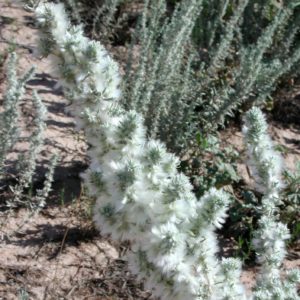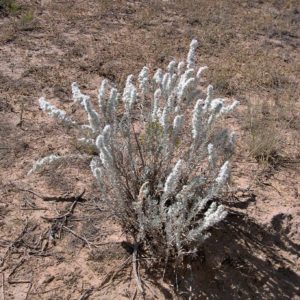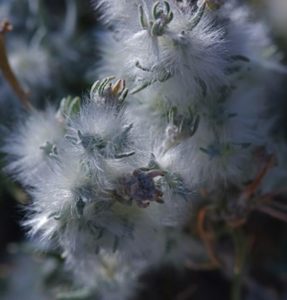Scientific Name: Krascheninnikovia ceratoides subsp. lanata
Common names: winterfat, winter sage, white sage, lamb’s tail
Family: Amaranthaceae (Amaranth)
Article by Susan Bruneni

SEINet Portal Network. 2019. Photo by Max Licher (CC BY-SA 3.0).
Winterfat is just what its name says it is, a rich source of nutrients for livestock and wildlife during bleak late winter and early spring days when fodder is scarce. In the rangeland, animals such as cattle, goats, and especially sheep graze on this valuable browse plants deemed excellent by the USDA due its 10-percent (or more) crude protein content in winter. It is native to New Mexico and most of the western United States from Canada to Mexico. It grows from sea level to 9,300 feet on rolling plains, slopes, rocky mesas and foothills. Winterfat is highly adaptable to various habitats and fluctuations in moisture.
But winterfat has an additional advantage in New Mexico. It is ideal for erosion control and reclamation projects, grows quickly under favorable conditions, and when planted in a mixture of native grasses it will create a greater plant density. It is very drought tolerant, grows in well-drained, calcareous soils, low salt concentrations and has a deep taproot with soil stabilizing extensive fibrous root system near the soil surface. Winterfat is classified by the USDA as a pioneer species because it establishes fairly easily on drastically disturbed sites or poorly developed soils. The USDA with partnering agencies has compiled extensive data on propagation and care of winterfat (see References).

SEINet Portal Network. 2019. Photo by Max Licher (CC BY-SA 3.0).
It is a low- growing, sub-shrub, typically with a central woody stem arising from a woody crown that can live for up to 130 years. Its light gray leaves are simple, alternate, mostly linear, and revolutely margined (rolled back from the margin). The inflorescence is a spike. Pollination usually occurs between plants, but self-pollination may occur on monoecious plants. Wind is the principal mode of pollination.
Active growth begins in early to mid spring, flowering occurs from mid spring to early summer, and seed maturity is reached by mid to late fall, with seeds remaining on the plant through the winter. This native perennial has velvety, silver hairy foliage in the spring and summer, becoming white and wooly from its ripe, horned seed heads in late fall and winter.
Winterfat grows well in a wide range of soil types, although it prefers more basic or limy soils. It tolerates moderate to highly saline conditions, but is not tolerant of acidic soils. It does not tolerate flooding or extended wet conditions.

Photo by Janice Tucker.
It’s soft, wooly appearance in winter makes winterfat an attractive addition to landscapes. But keep in mind that wildlife (or an occasional cow) will view it as a hearty winter dinner you have prepared just for their pleasure.
References:
“Krascheninnikovia lanata”. Wikipedia. Wikimedia Foundation. 14 July 2018. Web. 1 Feb. 2019. Retrieved from: https://en.wikipedia.org/wiki/Krascheninnikovia_lanata
“Krascheninnikovia lanata”. Garden Explorer. Santa Fe Botanical Garden. Web. 1 Feb. 2019. Retrieved from: https://santafebotanicalgarden.gardenexplorer.org/taxon-456.aspx.
Ogle, D.G., St. John, L., Holzworth, L., Winslow, S.R., and D. Tilley. 2012. Plant Guide for winterfat (Krascheninnikovia lanata). USDA-Natural Resources Conservation Service, Aberdeen, ID Plant Materials Center. 83210-0296.
“Winterfat”. Range plants of Utah. Utah State University Extension. Web. 1 Feb. 2019. Retrieved from: https://extension.usu.edu/rangeplants/shrubs-and-trees/SageWhite.
“Winterfat”. Pawnee Buttes Seed Inc. Web. 1 Feb. 2019. Retrieved from: https://pawneebuttesseed.com/seeds/winterfat/


